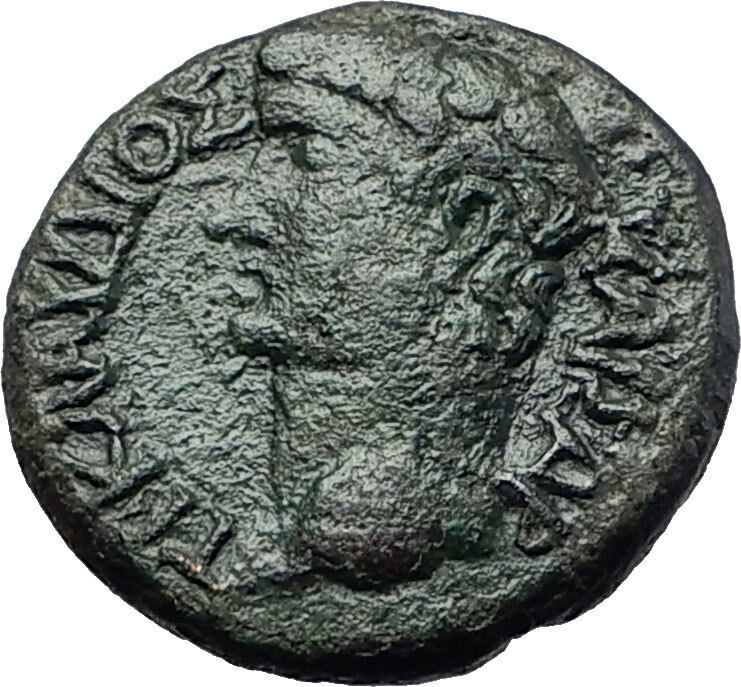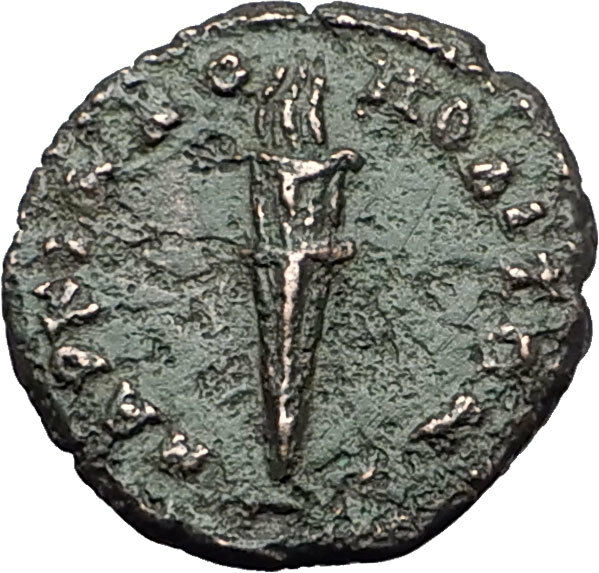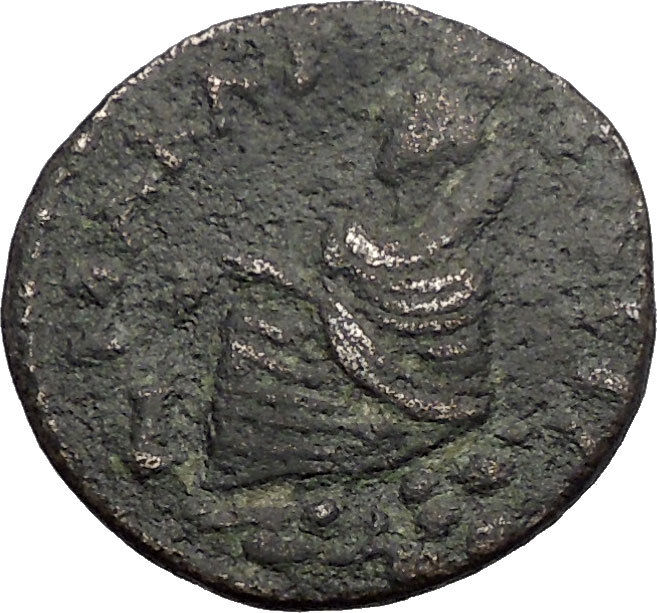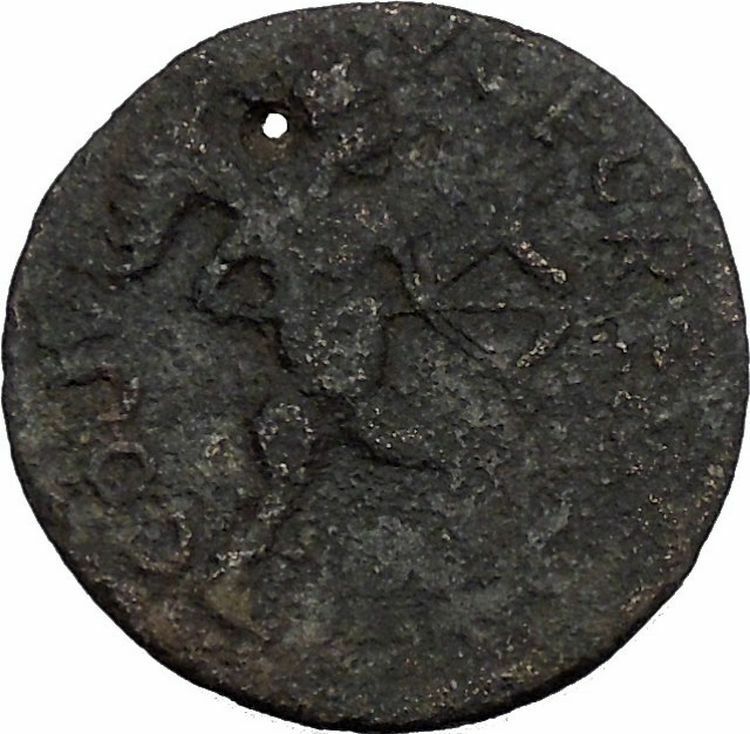|
Philip II
–
Roman Caesar
: 244-249 A.D. –
Bronze 28mm (16.25 grams) of Antioch mint 244-249 A.D.
Reference: GIC 4147; B.M.C. 20.219,566
AVTOK. K. M IOVΛI ΦIΛIΠΠOC CЄB, laureate, draped & cuirassed bust right.
ANTIOXЄΩN MHTPO. KOΛΩN, Veiled and turreted bust of City-goddess Tyche right,
ram running right above, star beneath; in field, Δ-Є / S-C.
You are bidding on the exact item pictured, provided with a Certificate of
Authenticity and Lifetime Guarantee of Authenticity.
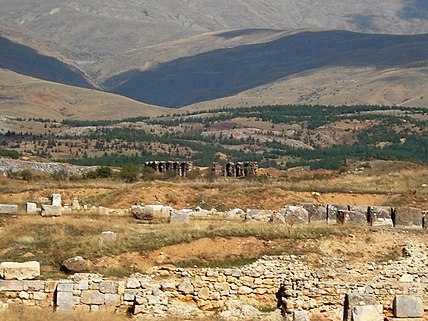
Antioch
in Pisidia – alternatively Antiochia in Pisidia or Pisidian
Antioch (Greek:
Ἀντιόχεια τῆς Πισιδίας) and in
Roman Empire
,
Latin
: Antiochia Caesareia or
Antiochia Caesarea – is a city in the
Turkish Lakes Region
, which is at the
crossroads of the
Mediterranean
,
Aegean
and Central
Anatolian
regions, and formerly on the border
of Pisidia
and
Phrygia
, hence also known as Antiochia in
Phrygia. The site lies approximately 1 km northeast of
Yalvaç
, the modern town of
Isparta Province
. The city is on a hill with
its highest point of 1236 m in the north.
Roman period
While the Hellenistic Kingdoms (the inheritors of
Alexander the Great
) were fighting each other
and the Galatians,
Rome
became the most powerful state in Europe
and started to follow a policy of expansion to the east. They invaded
Macedon
,
Thrace
, and the
Dardanelles
, and reaching
Phrygia
via
Magnesia
and Pisidia. They cowed the Galatians
and according to the
treaty
signed in
Apamea
in 188 BC, they gave the land of Pisidia
which they had got from
Antiochos III
, to their ally the
Pergamon
Kingdom which dominated the region.
Attalos III
, the last king of
Pergamon
, bequeathed his kingdom to Rome on his
death in 133 BC
Aristonikos
who claimed Pergamon was defeated
in 129, then Rome affected Anatolia with its well-developed, creative culture
for centuries.
Although Anatolia
was dominated by the
Roman Empire
as the
province of Asia
, Pisidia was given to the
Kingdom of Cappadocia
, which was an ally of Rome. During
the following years, the authority gap which could not be filled by these
kingdoms remote from central government, led to the rise of powerful pirate
kingdoms, especially in
Cilicia
and Pisidia. The Romans were disturbed
by these kingdoms and fought against them. Cilicia,
Pamphylia
,
Phrygia
and Pisida were freed from pirates and
Roman rule was restored in 102 BC.
The geographical and strategical position of the region made it difficult to
control the area and maintain constant peace. The
Homonadesians
, settled in the
Taurus Mountains
between
Attaleia
and
Ikonion
, caused problems for Rome.
Marcus Antonius
who had to control the roads
connecting Pisidia to Pamphylia, charged his allied king
Amyntas
, King of Pisidia, to fight against
Homonadesians, but Amyntas was killed during the struggle.
Then Rome started to colonize using military
legions
as a solution to the failure of the
locally appointed governors. The Province of
Galatia
was established in 25 BC and Antioch
became a part of it. To support the struggle against the Homonadesians
logistically, the construction of a road called the
Via Sebaste
, the centre of which was Antioch,
was started by the governor of the Province of Galatia,
Cornutus Arrutius Aquila
. The Via Sebaste was
separated into two and directed to the southwest and southeast to surround the
Homonadesians. Secondary connecting roads were built between these two roads.
Rome by means of the Via Sebaste
P.Sulpicius Quirinius
brought an end to the
Homonadesians problem in 3 BC, relocating survivors in different surrounding
locations.
During the reign of
Augustus
, eight colonies were established in
Pisidia, but only Antioch was honoured with the title of
Caesarea
and given the right of the
Ius Italicum
, maybe because of its
strategic position. The city became an important Roman colony which rose to the
position of a capital city with the name of “Colonia
Caesarea“.
Hellenisation
became Latinisation during the
Roman period and it was applied in Antioch best. The city was divided into seven
quarters called “vici”
all of which were founded on seven hills like in Rome. The formal language was
Latin
until the end of the 3rd century. The
fertility of the land and the peace brought by
Augustus
(Pax
Romana: Roman Peace) made it easier for the veterans as colonists
in the area to have good relations and integration with the natives.
One of the three surviving copies of the
Res Gestae Divi Augusti
, the famous
inscription recording the noble deeds of the Emperor Augustus was found in front
of the Augusteum in Antioch. The original was carved on bronze tablets and
exhibited in front of the
Mausoleum of Augustus
in
Rome
, but unfortunately has not survived. The
Antioch copy on stone was written in Latin which is a sign of the importance of
the city as a military and cultural base of Rome in Asia. (One of the copies, in
Greek
and
Latin
, is in
Ankara
, the other, in Greek, in Apollonia
-Uluborlu).
Tyche (Greek for luck; the Roman equivalent was
Fortuna
) was the presiding
tutelary deity
that governed the fortune and
prosperity of a city, its destiny. Increasingly during the Hellenistic period,
cities had their own specific iconic version of Tyche, wearing a
mural crown
(a crown like the walls of the
city).

The
Greek historian Polybius
believed that when no cause can be
discovered to events such as floods, droughts, frosts or even in politics, then
the cause of these events may be fairly attributed to Tyche.
Stylianos Spyridakis concisely expressed Tyche’s appeal in a
Hellenistic world of arbitrary violence and unmeaning reverses: “In the
turbulent years of the
Epigoni of Alexander
, an awareness of the
instability of human affairs led people to believe that Tyche, the blind
mistress of Fortune, governed mankind with an inconstancy which explained the
vicissitudes of the time.”
In literature, she might be given various genealogies, as a daughter of
Hermes
and
Aphrodite
, or considered as one of the
Oceanids
, daughters of
Oceanus
and
Tethys
, or of
Zeus. She was connected with
Nemesis
and
Agathos Daimon
(“good spirit”).
She was uniquely venerated at
Itanos
in Crete, as Tyche Protogeneia,
linked with the Athenian
Protogeneia
(“firstborn”), daughter of
Erechtheus
, whose self-sacrifice saved the
city.
She had temples at
Caesarea Maritima
,
Antioch
,
Alexandria
and
Constantinople
. In
Alexandria
the Tychaeon, the temple of
Tyche, was described by
Libanius
as one of the most magnificent of the
entire Hellenistic world.
Tyche appears on many
coins
of the Hellenistic period in the three
centuries before the Christian era, especially from cities in the Aegean.
Unpredictable turns of fortune drive the complicated plotlines of
Hellenistic romances
, such as
Leucippe and Clitophon
or
Daphnis and Chloe
. She experienced a
resurgence in another era of uneasy change, the final days of publicly
sanctioned
Paganism
, between the late-fourth-century
emperors
Julian
and
Theodosius I
who definitively closed the
temples. The effectiveness of her capricious power even achieved respectability
in philosophical circles during that generation, though among poets it was a
commonplace to revile her for a fickle harlot.
In medieval art
, she was depicted as carrying a
cornucopia
, an
emblematic
ship’s rudder, and the
wheel of fortune
, or she may stand on the
wheel, presiding over the entire circle of fate.
The constellation of
Virgo
is sometimes identified as the heavenly
figure of Tyche, as well as other goddesses such as
Demeter
and
Astraea
.
Marcus
Julius Philippus Severus, also known as Philippus II, Philip II
and Philip the Younger (238 – 249) was the son and heir of the
Roman
Emperor
Philip the Arab
by his wife Roman Empress
Marcia Otacilia Severa
. According to numismatic evidence, he had a sister
called Julia Severa or Severina, whom the ancient Roman sources do not mention.
When his father became emperor in 244 he was appointed
Caesar
. Philippus was
consul
in 247
and 248. His father was killed in battle by his successor
Decius
in 249.
When news of this death reached Rome, he was murdered by the
Praetorian Guard
. He died in his mother’s arms. When he died, he was eleven
years old.
|








